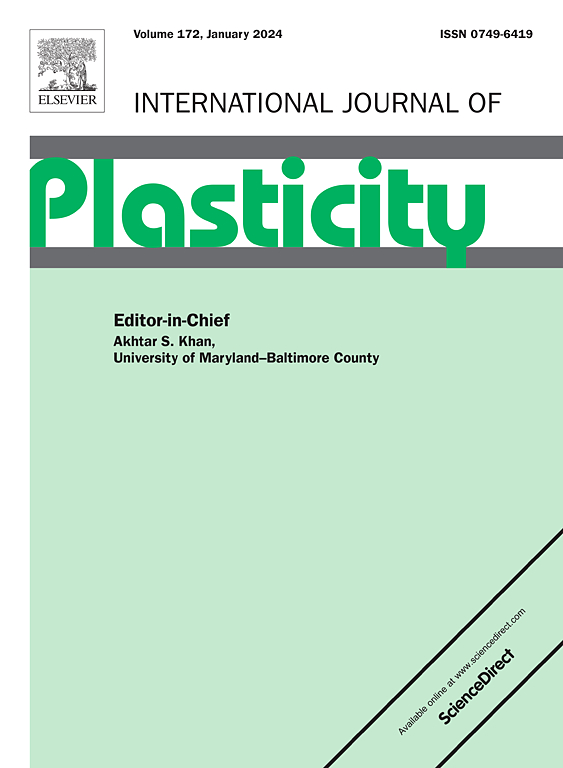同步x射线衍射与层析成像研究铝合金变形行为的加工工艺对比分析
IF 9.4
1区 材料科学
Q1 ENGINEERING, MECHANICAL
引用次数: 0
摘要
再生Al-Cu合金由于粗大的富铁金属间相(富铁相)引起应力集中而导致力学性能恶化。本研究旨在比较分析超声熔体加工(USMP)和Al-Ti-B工艺对Al-Cu合金组织和变形行为的影响。利用扫描/透射电子显微镜、电子背散射衍射、同步加速器x射线衍射和断层扫描等多种显微技术对其进行了研究。热处理后的Al- cu合金含有初生Al相、Al7Cu2Fe相和Al15(FeMn)3(SiCu)2相。与0.7 feb (0.7 wt% Fe + Al-Ti-B)合金相比,0.7 feu (0.7 wt% Fe + USMP)和0.7 feub (0.7 wt% Fe + USMP + Al-Ti-B)合金的晶粒尺寸分别减小了25.7%和42.2%。这种细化导致了机械性能的显著改善:0.7FeUB的屈服强度、抗拉强度和伸长率分别提高了18.7%、53.7%和216.7%。USMP导致富铁相的细化和致密,降低了应力集中。拉伸试验中,0.7FeUB合金的细晶粒向多个方向旋转,促进了均匀的塑性变形和应力分布。与0.7FeB合金相比,0.7FeU和0.7FeUB合金断裂前的最大晶格应变分别提高了100%和142%。USMP还增强了Cu和Mg的溶解度,导致细小的析出物和位错密度增加,通过固溶、析出和位错强化强化合金。本文章由计算机程序翻译,如有差异,请以英文原文为准。
Comparative analysis of processing technology on the deformation behavior of Al alloys studied by synchrotron X-ray diffraction and tomography
Recycled Al-Cu alloys deteriorated mechanical properties due to stress concentration caused by coarse Fe-rich intermetallic (Fe-rich phases). This study aims to comparative analysis of processing technology of ultrasonic melt processing (USMP) or/and Al-Ti-B on microstructure and deformation behavior of Al-Cu alloys. They were investigated using various microscopy technique, such as, scanning/transmission electron microscopy, electron backscattered diffraction, and synchrotron X-ray diffraction and tomography. Heat-treated Al-Cu alloys contained primary Al phase, Al7Cu2Fe, and Al15(FeMn)3(SiCu)2 phases. The grain sizes of the 0.7FeU (0.7 wt.% Fe + USMP) and 0.7FeUB (0.7 wt.% Fe + USMP + Al-Ti-B) alloys decreased by 25.7% and 42.2%, respectively, compared to the 0.7FeB (0.7 wt.% Fe + Al-Ti-B) alloy. This refinement led to significant improvements in mechanical properties: yield strength, tensile strength, and elongation increased by 18.7%, 53.7%, and 216.7% for 0.7FeUB. USMP resulted in a refined and compact morphology of the Fe-rich phases, reducing stress concentration. Under tensile testing, the fine grains in the 0.7FeUB alloy rotated in multiple directions, promoting uniform plastic deformation and stress distribution. The maximum lattice strain before fracture increased by 100% and 142% for the 0.7FeU and 0.7FeUB alloys, respectively, compared to the 0.7FeB alloy. USMP also enhanced Cu and Mg solubility, resulting in fine precipitates and increased dislocation density, strengthened alloys through solid solution, precipitation, and dislocation strengthening.
求助全文
通过发布文献求助,成功后即可免费获取论文全文。
去求助
来源期刊

International Journal of Plasticity
工程技术-材料科学:综合
CiteScore
15.30
自引率
26.50%
发文量
256
审稿时长
46 days
期刊介绍:
International Journal of Plasticity aims to present original research encompassing all facets of plastic deformation, damage, and fracture behavior in both isotropic and anisotropic solids. This includes exploring the thermodynamics of plasticity and fracture, continuum theory, and macroscopic as well as microscopic phenomena.
Topics of interest span the plastic behavior of single crystals and polycrystalline metals, ceramics, rocks, soils, composites, nanocrystalline and microelectronics materials, shape memory alloys, ferroelectric ceramics, thin films, and polymers. Additionally, the journal covers plasticity aspects of failure and fracture mechanics. Contributions involving significant experimental, numerical, or theoretical advancements that enhance the understanding of the plastic behavior of solids are particularly valued. Papers addressing the modeling of finite nonlinear elastic deformation, bearing similarities to the modeling of plastic deformation, are also welcomed.
 求助内容:
求助内容: 应助结果提醒方式:
应助结果提醒方式:


